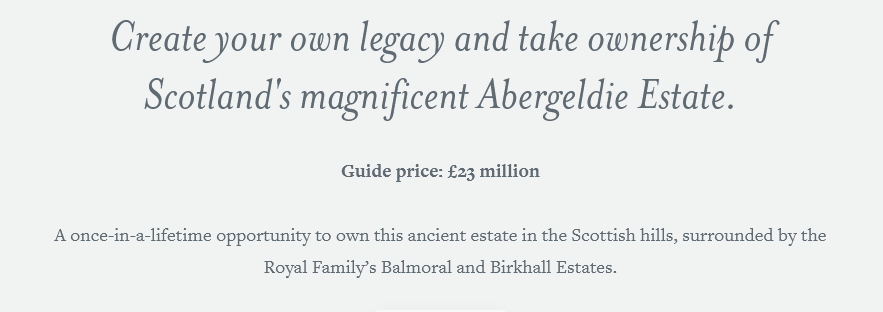
The Abergeldie Estate, which I referred to in my post on the Royal Family last week (see here), is now under offer. That is hardly surprising. There are plenty of billionaires in the world for whom forking out £23m to become neighbours of the Royal Family is small change. Whether the prospective buyer will be prepared to challenge the way the Royal Family are currently managing the “sporting rights” at Abergeldie is another matter:
“Abergeldie holds salmon fishing rights on the internationally renowned River Dee – rights that are presently leased to the Balmoral Estate…………………………. Similarly, Balmoral currently holds a short lease on Abergeldie’s wider sporting rights, including deer and grouse shooting.”
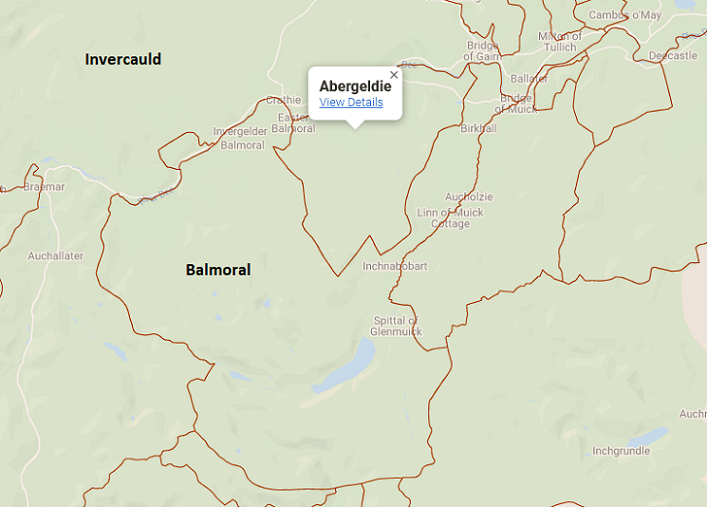
A ruined landscape
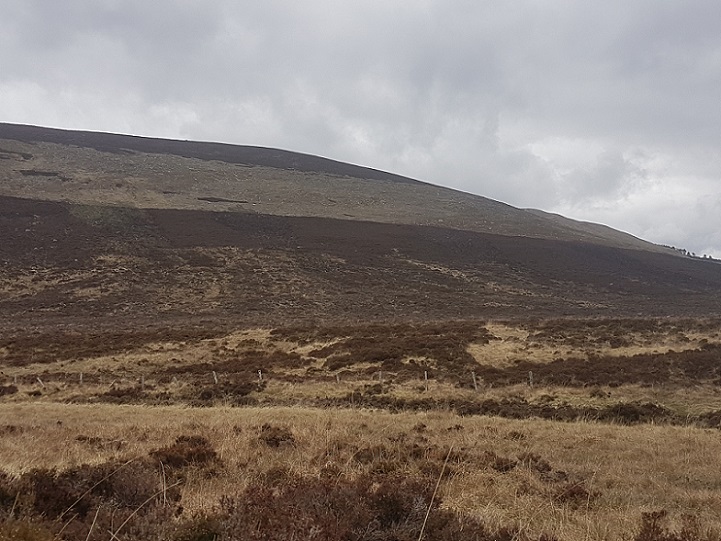
The sales brochure for Abergeldie (see here) reveals that the Royal Family have leased the sporting on the estate almost continuously since they bought Birkhall in Glen Muick from the Gordon family in 1848:
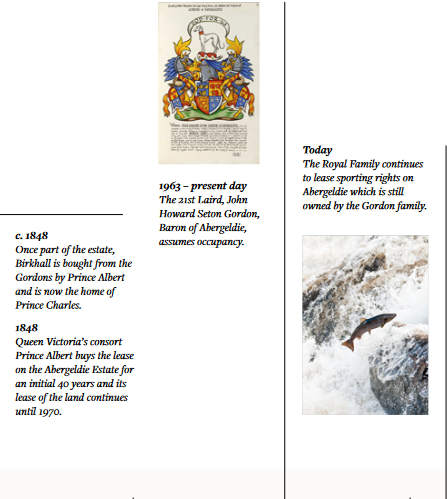
According to information on Who Owns Scotland, Andy Wightman’s database on landownership, in 2010 the Royal Family held a long lease on the sporting rights at Abergeldie. It has now, apparently, been replaced by a short lease.
The sales brochure states that of the estate’s 11,512 acres, 600 acres is farmland, 2,683 acres is woodland and “the balance of the remaining acres is wild heather moorland and hills“. This is accompanied by a lot of tartan sales speak which bears little resemblance to reality, for example:
“Thousands of acres of wilderness, woodland and farmland, on the banks of the famous River Dee. A place of nature, wildlife and country pursuits; of stories from the past and possibilities for the future. A place to beguile and inspire. A truly special place in the land of malt whisky, castles and
stately country houses.”
The remaining acres are actually anything but wild, as is demonstrated by this satellite photo from Google Earth:

Most of the Abergeldie Estate is intensively managed grouse moor and has been burnt to bits, releasing carbon into the atmosphere and preventing peat formation and woodland restoration. Responsibility for this destruction lies with the Royal Family who were vocal at COP 26 about the need to address the climate and nature emergencies and the importance of global leadership.
Unfortunately, few people are aware of how the Royal Family manage the moorland at Abergeldie under their lease. The area is conveniently out of sight of tourist thronged Glen Muick or the northern approach to Lochnagar and even fewer members of the general public visit.
An illustration of the way the Royal Family is managing Abergeldie
One person who does know about Abergeldie, however, is Graeme Rose, the person who discovered the trapped gull at Invercauld (see here) and who for several years has been recording raptors around Balmoral. He has shared with parkswatch the correspondence he attempted to have with Prince Charles about the merlin that used to nest on Meall Dubh (photo above). His letter to Prince Charles, dated 12th January 2021, is measured and rational and well worth reading (see here).
Unfortunately, it does not appear that Prince Charles replied to the letter about the merlin on the land that is managed for his shooting pleasure. On 2nd February Graeme received a letter from Richard Gledson, the factor at Balmoral, who stated that the letter had been passed to him to respond. His response is sporting estate speak:
Graeme Rose’s response to Richard Gledson, which was also sent to Prince Charles, is again measured and polite and worth reading in its entirety (see here) but it’s worth highlighting what he said about breeding merlin at Balmoral:
“Merlins bred in the Meall Dubh nest area in 2014, 2015 and 2017. I have no records since. It is possible that burning reduces the insect population, which reduces the Meadow Pipit population, which reduces the Merlin population. (Reference: Population and breeding biology of the Merlins in the Lammermuir Hills, January 2017, British Birds 110:138-154 (see here)).
In each of the last two seasons the Balmoral rangers have notified me of one successful pair of Merlins (located in the Girnock catchment). I’m not aware of any other successful breeding attempts on land managed by Balmoral in 2019 and 2020. Given that in a good year the Girnock can support three pairs, the upper Muick three and other parts of the estate at least two, I don’t understand how the Balmoral population can be said to be holding up reasonably well. It may be the case but it’s not my opinion based on the evidence I have.”
The facts contradict Mr Gledson’s assertion that muirburn increases biodiversity. The truth is that as well as releasing carbon into the atmosphere it creates a heather/grouse monoculture where almost nothing else can flourish. What’s happening to merlin suggests that biodiversity on Abergeldie has collapsed as a result of the Royal Family’s management of the land for grouse shooting (see here for a short video of a royal crow trap in the Girnock catchment). Neither Mr Gledson nor Prince Charles have responded to Graeme’s second letter.
While the Estate Management statement for Abergeldie on the Cairngorms National Park Authority website (see here) currently contains one word (“example”!), that for Balmoral (see here) is public and very clear:

Sadly that approach, which is all about managing the land for the private pleasure the Royal Family derive from shooting, also appears to have been applied to Abergeldie. The climate and environmental emergencies are matters for other people to tackle in other places. Unfortunately our public authorities appear totally incapable of challenging what the Royal Family have been doing or their hypocrisy and it’s left to individuals, like Graeme Rose, to attempt to do so.
Continued public subsidy for damaging land-use practices in the National Park
The current owners of Abergeldie appear to be John HS Gordon and Gillian A Gordon. The DEFRA Rural Payments database reveals that in 2019 the Gordons received a total of £63,510.66 including £16,707.17 for “greening practices”.

And then in 2020 they received a further £62,415.28 including £16,752.11 for “greening”:
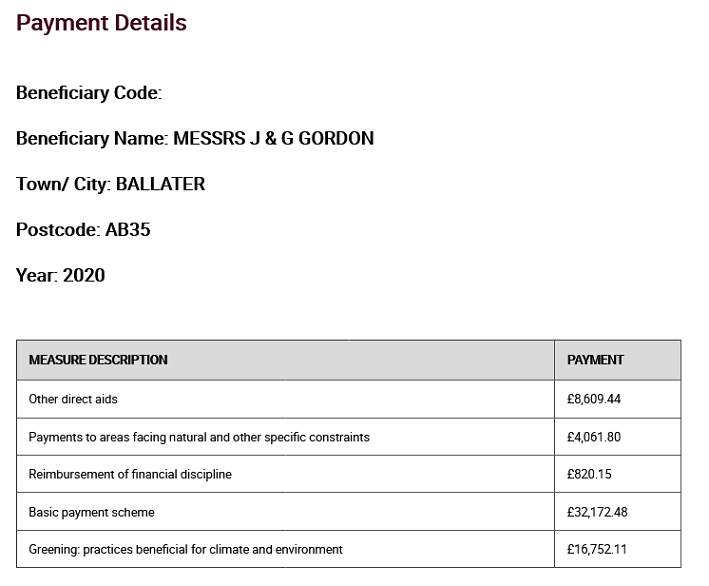
The muirburn featured above which has been taking place in Glen Girnock promotes water run-off which drains into the River Dee just above Ballater. That village was seriously damaged by flooding in 2015 but the area included in the Ballater Flood Protection Study which followed (see here) excludes moorland and thus any consideration of how the management of land by the Royal Family for field sports contributed to the disaster. While people in Ballater have suffered, the landowners have continued to be rewarded financially for their management of the land. The idea of cross-compliance, that landowners should only received public subsidy if they manage ALL their land in the public interest, appears to have been lost completely.
The Cairngorms National Park Partnership Plan (NPPP) provides an opportunity to reverse that and stop the mis-use of public money. The Scottish Government has agreed the CNPA should become a Regional Land Use Partnership (RLUP) which will then administer rural payments in the National Park (although there is still a policy decision to be made about how far RLUP’s will have discretion to decide how rural payments are made). The draft NPPP which is currently out for consultation states:

This is welcome. It could stop estates like Abergeldie and Balmoral being rewarded for damaging the land and releasing carbon into the environment. However, as I pointed out in my last post, at present this objective and the requirement for plans only applies to farms, not estates. The CNPA needs to extend the objective to cover estates.
Landownership issues
Scotland is unusual in world terms because most of the land in our National Parks is privately owned. Large areas of land are still being sold on the open market without any consultation with the National Park Authority and without any commitment on the part of new owners to abide by our National Parks statutory duty to promote conservation, sustainable land-use etc. This serves to undermine those objectives. Very rich people can buy places like Abergeldie for no better reason than they want to be neighbours of the Royal Family – though where they might entertain them given that Abergeldie Castle is excluded from the sale is unclear. Perhaps a planning application for a new castle will follow?
The new owner of Abergeldie is likely to find it very difficult to end the damaging sporting lease to the Royal Family without risking the opportunity of being invited round to Balmoral or Birkhall for dinner. Conversely, if the Royal Family was to commit to ending intensive management of grouse moors on their land, I suspect their new neighbour would almost certainly follow their lead. What happens next at Abergeldie is up the Royals.
Intensive management for field sports is not the only land ownership issue at Abergeldie. The sale includes 34 residential properties. The new laird will effectively acquire the power to decide who can live in the area and how housing is used, e.g. whether as affordable rented accommodation or as holiday lets.
What needs to happen
The Abergeldie sales brochure states that “the new owner could capitalise on grant-supported
woodland creation schemes”. Having done nothing to prevent damaging land-management practices, the Scottish Government’s rural subsidy system appears to be gearing up to pay landowners to restore all the damage they have caused. That is morally wrong.
There is a much better alternative at Abergeldie. The Royal Family were almost certainly given first offer on the estate (because it is enclosed by Balmoral) but declined. They should reconsider given the importance of their showing global leadership in the climate and environmental crises. They could offset the cost and set an example by selling off the housing to a rural housing association to provide much needed affordable accommodation locally. The balance of the £23m would the only cost a royal painting or two.
The Royal Family could then commit to restore Abergeldie and the land at Balmoral by immediately ending muirburn and other practices associated with intensive grouse moor management, reducing deer numbers over the next couple of years and creating the conditions where the environment could regenerate naturally as it is doing in places like Glen Feshie and the Mar Lodge regeneration zone.
If the Royal Family really care about climate change and the natural environment they could aspire to having the open land at Balmoral and Abergeldie declared a new National Nature Reserve, a place where nature came first, within the next ten years. The number of nesting pairs of merlin would be a worthy indicator of success.

Title on the particulars says it all.
Do you no fancy creating your own legacy by buying with help of crowdfunding and showing how the future could be?
Whomsover wrote this piece neither knows nor understands Upland management- (or ownership) .
The possession of extensive areas of Highland Scotland requires a deep understanding of great many complex aspects – a knowledge demonstrably all too lacking in those (more often than not) based in urban areas who self-importantly seek to impose their Ignorant – and, generally ‘woke’ and ‘politically correct’ opinions – upon those who live, and work, in these areas.
The great majority of those who have either come to inherit Highland Estates, or who have purchased same, know all too well that they will never profit from same financially – their ownership is an inspiring demonstration of custodianship of nature in all its aspects – and their putting their mouths – and money – where absolutely none of any of the ‘Green’ or ‘ ‘Woke’ whingers ever will or, can.
Hi Paddy, if landowners never profit financially, could you show me the £23m in debts owed by Abergeldie? Otherwise, was is the £23m except profit? As for the inspiring demonstration of the custodianship of nature, if you have access to records of wildlife on Abergeldie or other estates I would be delighted to publish them…………………..
Well explained – please, all those who think they have an understanding of these estates, put your views aside whilst taking time to study and reflect on the evidence. Look in depth at the whole picture and then form your opinion based on full possession of ALL the facts.
If your views change, take heart and carry on your exploration; if they don’t then no-one can criticise your standpoint.
Please, take time to reach a truly objective view.
The payments made to Abergeldie for greening refer to greening practices at Abergedie Mains and Home farms, as well as the area bordering the River Dee. Any payments made to land under lease to Balmoral would be Balmoral’s concern.